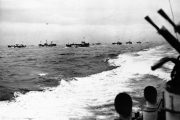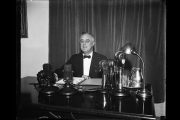Betsy Ross didn’t sew the first flag. Jesus wasn’t really born on December 25. Columbus didn’t discover America. We hear these statements all the time, for we live in an era where the foundational stories that define our national identity and bind us together as a people are being constantly deconstructed. We are told that the heroic stories of the founding of Christianity and the founding of our great republic are mere myths, factually inaccurate, and no more important or meaningful than the fanciful fairy tales told to amuse children.
We live in a skeptical age. Even the most optimistic and far-sighted among us must at times trudge blindly through a disorienting swirl of attacks on our faith, our families, and our country. While there is no sure tonic to ease the nauseous vertigo that often accompanies this struggle, there is a salve to be found in the tales we have been taught and in the truth and moral enrichment to be found therein. Whether for our own retrenchment or for that of our children, we can, we must, turn again to the record of our noble and brave ancestors to remind ourselves of the otherwise insurmountable odds they overcame to bequeath us with such a rich legacy of liberty.
One of the most impressive stories from our history is that of the small band of brethren who fled their homes seeking a place where they could worship freely. This courageous congregation is known as the Pilgrims.
Poor Wayfaring Strangers
The congregation of pious Christians known to history as Pilgrims was in their own time called Separatists for their schism with the greater Church of England. Dissension from the Church of England was illegal during the reign of King James the First, and the king was determined to brook no effrontery to his royal highness. He would sooner purge his country of disloyal subjects than allow those subjects to effect a purge of the state religion of which the king was the titular head. To enforce his egotistical and tyrannical will, James sent agents far and wide into the country to round up those Separatists reportedly meeting in secret in small groups to avoid detection by the king’s sycophantic spies.
Fearing imprisonment or worse at the hands of the royal agents, 400 English Separatists fled their beloved England. They sailed surreptitiously to Holland (leaving England without permission was a crime), where the atmosphere was more accommodating to those given to alternative (read: unofficial) interpretations of the word of God. The Dutch were historically more tolerant of religious dissidents and would permit, within limits, pilgrims of many religious creeds to assemble without fear of reprisal or persecution.
Although the Pilgrims found a welcoming harbor in Holland, it proved to be a brief respite, as political situations altered as crucial peace treaties with Spain and France expired, leaving Holland politically unallied and therefore exposed to the avarice of other less-progressive states. As the climate in Holland became decreasingly hospitable, the Pilgrims met to formulate a new plan and consider the options open to them. It was decided that, despite the possible implications, they would return to England, and they immediately set about acquiring investors to fund their ultimate journey: to America. The Pilgrim pastors believed unwaveringly that God’s will was manifest in their wanderings and privations, just as it had been with the Children of Israel in Egypt. After 40 years, the Israelites crossed over the Jordan and entered into the Holy Land, a land promised to them by their God and his prophets. Like the chosen people of the Old Testament, the Pilgrims had faith that they would be led to a land of milk and honey on the western shore of their own River Jordan — the Atlantic Ocean.
Plymouth Rock
The Pilgrims passed through trials of turbulent seas, uncharted courses, scurvy, and vile sickness that decimated their already small community, as well as intrigue, treason, and treachery. As a reward God delivered His faithful flock to the promised land, a land where they would at last be absolutely free from religious persecution and would live under laws framed and executed fairly and justly.
Upon reaching the shores of their new home, the Pilgrims dropped to their knees with an outpouring of gratitude toward the Almighty. Rising from their knees, the Pilgrims would have noticed an enormous rock. Yes, Plymouth Rock. We’ll never know whether or not any of our Pilgrim Fathers stepped foot on it or climbed over it before going farther inland. What is known is that this small band of believers, bound together by sacred covenant and civil compact, overcame insuperable odds that would scuttle most other, less devout and determined settlers. These Pilgrims, for so they were, were a stout albeit peripatetic lot that had nowhere left to go and therefore carved, literally, a new home, a New England, for themselves. Separated by thousands of miles from the religious intolerance and oppression of King James, these Separatists were now free to worship as they chose. The Pilgrims, looking up at a rock that history would call Plymouth Rock in their honor, recalled that their Lord commanded them to build upon such a strong immovable foundation, and thus they were wanderers no more.
Mayflower Compact
Before being allowed to debark, the leaders of the Pilgrim colony required all male members to enter into an agreement setting out the metes and bounds of rights and responsibilities in the new world. Normally, these sorts of issues would be predetermined within the patent granted by the crown. In the Pilgrims’ case, however, they had dropped anchor in a land outside the region assigned them in the patent. They were essentially operating outside of the law, so they needed new guidelines to direct both the Pilgrims and the others who accompanied them to America (over half of the passengers on board the Mayflower were not Pilgrims). Before leaving Holland, one of the Pilgrims’ pastors who was to stay behind and prepare the second wave of travelers, John Robinson, instructed his followers to form a secular civil government, so to begin the colony in the manner in which they intended to go on, that is to say, in an orderly and tolerant fashion. As he rightly reckoned, making a secular compact with the nonbelievers demonstrated good faith and sound reason on the part of those whom many believe to be overzealous religious reactionaries.
The document signed by 41 of the 50 male adults on board the Mayflower (the other nine were either too ill or were headed straight back to England) has been described as an example of “crystalline brevity.” The text is worthy of repetition in its entirety.
We whose names are underwritten, the loyal subjects of our dread sovereign Lord, King James, by the grace of God, of Great Britain, France and Ireland king, defender of the faith, ect., having undertaken, for the Glory of God and advancement of the Christian Faith and Honour of our King and Country, a Voyage to plant the First Colony in the Northern Parts of Virginia, do by these presents solemnly and mutually in the presence of God and one of another, Covenant and Combine ourselves together into a Civil Body Politic, for our better ordering and preservation and furtherance of the ends aforesaid; and by virtue hereof to enact, constitute and frame such just and equal Laws, Ordinances, Acts, Constitutions and Offices, from time to time, as shall be thought most meet and convenient for the general good of the Colony, unto which we promise all due submission and obedience. In witness whereof we have hereunder subscribed our names at Cape Cod, the 11th of November, in the year of the reign of our Sovereign Lord King James, of England, France and Ireland the eighteenth, and of Scotland the fifty-fourth. Anno Domini 1620.
Although in many ways unremarkable and certainly not revolutionary, this brief contract is one of our Republic’s foundational documents and was an example of Puritan pragmatism. These men and women, faced with a silent coast with nothing to anticipate but hardship and fresh despair, bound themselves together into a community of far-flung Englishmen committed to prospering and preserving their natural-born right of self-determination.
The First Thanksgiving
Now for the part of the story familiar to second graders with paper belted hats and multi-colored feather headbands and all those who have attended the annual plays acted out in gyms and cultural halls throughout the country. The Pilgrims had much to be thankful for and they knew it. The steadying Hand of Providence led them safely across the ocean, and they had been blessed with strength to build houses and common buildings (the first was erected on Christmas Day, 1620). Next, they had to plant crops so that they might fulfill the measure of their divine commission and perpetuate their colony here in the New Canaan. This forested land with abundant flora and fauna was promised, indeed, but the soil was strange and successful horticulture was a conundrum. Enter the Indians.
It is true, as we all remember from lessons that were once taught in school, that the Pilgrims and the Indians sat down together and partook of the fruits of their labors, ate turkey and venison, and benefited from mutual instruction and genuine fellowship. This assembly was remarkable for many reasons; chief among them, perhaps, was the sensational account of Indian atrocities told to the Pilgrims while they tarried in Holland. The Indians, they were told, “delight to torment men in the most bloody manner that may be; flaying some alive with the shells of fishes, cutting off the members and joints of others by piecemeal and broiling on the coals.” With this image seared into the front of their minds, as soon as they arrived in America the Pilgrims were quick to erect barricades and post sentries to protect them from the natives they believed to be bloodthirsty savages.
In truth, in the beginning the Pilgrims and Indians did clash, sometimes violently. The fault, however, was never one-sided and the peace was always quickly restored. By the time of the harvest of 1621, several peaceful months had passed since the Pilgrims had any scrapes with the native inhabitants of the land, and they were feeling safe and secure and had redirected their minds and efforts toward harvesting their crops and building all the necessary infrastructure to support the thriving colony they designed and were determined to establish.
It was in this atmosphere of progress, peace, and planned prosperity that made possible one of the momentous greetings in American history. One Friday afternoon, a Pokanoket Indian calling himself Samoset walked up to a Pilgrim and announced, “Welcome, Englishmen!” Hardly the senseless savagery described in such vivid, gory detail by teachers in Dutch schools. As a matter of fact, the Indians genuinely welcomed the newcomers and demonstrated their goodwill by teaching the eager though ignorant European farmers a little something about American agriculture.
Samoset taught the Pilgrims that because of the unique chemical composition of the local Massachusetts soil, it was essential that the ground be fertilized to balance the soil and make it more nourishing to the corn and other crops planted by the Pilgrims. The fertilizer preferred by the Indians after years of experimenting was dead herring. The Pilgrims trusted the advice of Samoset, and the autumn of 1621 saw a bumper crop of corn, squash, beans, barley, and peas. It was a harvest worthy of giving thanks — thanks to God and thanks to the Indians who shared valuable information.
The precise date was not recorded, but sometime in late October or early November, about 100 Indians walked into the Pilgrim settlement (now occupied by several common buildings and log homes) carrying deer hunted specially for this harvest feast. The Pilgrims, about 50 in number, provided turkey (turkey from the New World was being eaten in England for about 40 years and was already a staple of English Christmas dinner), other fowl, deer, and beer. The meat was cooked on spits over open fires. The weather that season was crisp, but not cold, and the Pilgrims no doubt were fascinated by the bright fall foliage, a palette of colors not seen in England because of the perpetual dampness and lack of sunlight.
The congregation, Indians and Pilgrims, sat down in small groups on the ground and around small round tables and ate their dinner. The scene would not seem so foreign to us, their descendants, except for the fact that there were no forks (not in use in Massachusetts for another 70 years), no cranberry sauce, and no pumpkin pie. The food that was eaten was washed down with beer, the beverage of choice for saint and sinner in England because of the notoriously contaminated water available throughout the country. Thankfully, the bountiful barley crop in their new home made brewing easy.
Lessons Our Fathers Learned
As the foregoing demonstrates, there is much truth in the stories we have been taught regarding our Pilgrim Fathers and the First Thanksgiving they celebrated with the Indians that shared that small plot of earth with them. The fact that the Pilgrims succeeded where so many other erstwhile colonists had failed was due in large measure to the kindness, generosity, and trust shown to the Pilgrims by Massasoit and his small tribe. These men and women, believed to be savages but proven to be “very trustworthy, quick with apprehension, ripe witted, and just,” reached out to their neighbors and extended a hand of fellowship. So often, this hand was slapped away by frightened Europeans. The Pilgrims, themselves frequent victims of treachery and sabotage, took the hand of the Indians and shook it. They sat together, ate together, and grew together.
Even in light of the timely and invaluable aid proffered by the Indians, more than any other consideration it was the tireless and firm faith of our Pilgrim Fathers that kept them alive and animated their steadfast resolve to bloom where the Hand of the Almighty God had planted them, no matter how rocky, unknown, and hostile the soil.
This article was originally posted online on November 23, 2009.




